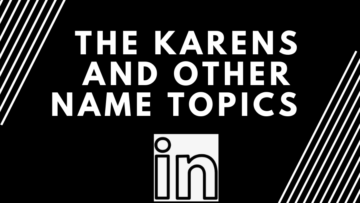Many executives, particularly those in C-suite positions, often write their LinkedIn About section with their third-person BIO rather than a first-person approach.
Here are several reasons why:
Formality & Professionalism
Third-person writing, a common choice among senior executives, conveys a sense of formality and professionalism. It aligns with the public face executives represent in their company role. Third-person writing resembles the official communication for press releases.
Traditional BIO for Consistency
Senior executives may be accustomed to seeing third-person BIOs in corporate settings, such as on company websites, media profiles, or during speaking engagements. Maintaining this format on LinkedIn ensures consistency across various platforms and communication channels.
Brand Recognition
For C-suite executives, personal branding often overlaps with the company’s brand. A third-person BIO:
- Provides a more neutral tone
- Emphasizes the executive’s organizational role rather than personal achievements
- Reinforces the idea that they speak not only as an individual but as a company representative
Objectively Highlighting Accomplishments
Writing in the third person lets executives showcase their accomplishments without sounding self-promotional. For instance, “Jane led the company and increased revenue by 35%” sounds more objective than “I led the company…”.
C-Suite Expectations & Familiarity
Since third-person BIOs are standard in many corporate settings, it’s understandable that C-suite executives may default to this format on LinkedIn. The style feels familiar and may align with industry expectations.
C-Suite Authoritative Distancing
A third-person BIO can effectively create a sense of distance between the individual and the reader, reinforcing authority and leadership. This tone may convey formality and position senior executives within a professional context.
Use for Public Relations and Press Releases
Executives often repurpose their BIOs for conferences, media, or press releases. Writing in the third person simplifies the process for PR professionals, journalists, and other external users who need to quote or reference the BIO without rewriting it.
While a first-person BIO can feel more engaging, personal, and authentic, many C-suite professionals prioritize consistency, formality, and alignment with their role when crafting their LinkedIn profiles.
But … There are Downsides
Although writing in the third person and using dense paragraphs is common, it may not always be the most effective approach, particularly on a platform like LinkedIn.
1. Decreased Readability
Dense blocks of text can be visually overwhelming and difficult to skim and scan, which is how many LinkedIn users read profiles. Long paragraphs may deter users from engaging with the content. I find my attention slipping when confronted with dense paragraphs.
2. Lack of Engagement
Without clear, digestible highlights and labeled section blocks, readers may lose interest and leave the profile before engaging with key points. Breaking up text into bullet points or concise sections with clear headings makes the BIO more reader-friendly. Consider adding some well-placed emojis to enhance visual appeal!
3. Missed Opportunities for Key Information
Long paragraphs can bury essential points like achievements with metrics along with key skills. LinkedIn is often used for networking and career opportunities, so these details must stand out. Keywords can easily get lost, which may harm visibility to the human eye in search results.
4. Less Impactful First Impression
LinkedIn only displays the first few lines of the “About” section before prompting users to click “See more.” If these initial lines fail to grab attention, you may lose readers before they engage with the rest of your profile, hence the importance of a strong opening.
5. Reduced Searchability and SEO
Could critical keywords embedded deep within paragraphs impact SEO? Shorter sentences and strategic keyword placement in headings or bullet points may enhance your profile’s discoverability in searches. While I can’t be sure, not having access to the algorithm and back-end engineering, I know my visual preferences on the front end!
6. Does Not Stand Out
A densely written BIO can cause your profile to blend in rather than stand out and not tell your story. You can make your BIO more dynamic and visually appealing by using shorter sentences, bullet points, well-placed emojis, and capitalized keywords,
7. Views Are Different on Mobile Devices
With many LinkedIn users accessing the platform on mobile devices, long paragraphs are more challenging to navigate on smaller screens. Simplifying your BIO into digestible sections improves readability for mobile users.
8. Missed Personal Connection
A conversational tone may be lost in lengthy paragraphs. Shorter sections make injecting personality and authenticity easier to create a more relatable profile. Including personal interest details can also serve as icebreakers, helping to humanize your BIO.
9. Accomplishments Not Highlighted
Their impact can be diminished when key metrics and achievements are buried within long paragraphs. Bulleted lists or shorter sections help ensure your quantifiable accomplishments stand out, making a more significant impression on the reader.
Conclusion
To keep readers engaged and maximize the impact of your LinkedIn profile, consider breaking up the ‘About’ section into short paragraphs or bullet points.
This alternate structure, compelling hooks early, strategic keyword placement, and showcasing of quantifiable accomplishments can significantly enhance the reader’s experience. Readers may feel more engaged and interested. Ultimately, it’s about what works best for your professional goals!
NEXT STEPS
- Subscribe to my newsletter on LinkedIn™ for bright ideas on how to manage your career.
- If you need a resume or LinkedIn™ profile to get you to your next step, book a call to chat! Can’t beat a free discovery call!
- Join as a member at https://greatcareers.org/membership of the #1 business networking association on the Philadelphia Business Journal’s Book of Lists four years in a row!
- To support our charity at KeepOnSharing.com and use the referral code Career
- Follow #GreatCareersPHL
BIO
Lynne M. Williams is the Executive Director of the Great Careers Network, a volunteer-run 501(c)3 nonprofit organization that provides career development and networking connections for 1) job seekers in career transition, including veterans, and 2) employed and self-employed for career management.
Aside from writing keyword-focused content for ATS resumes and LinkedIn profiles, Lynne is writing her doctoral dissertation on LinkedIn for Job Seekers. She is a contributing author on “Applying to Positions” in Find Your Fit: A Practical Guide to Landing the Job You Love, along with the late Dick Bolles, the author of What Color is Your Parachute?, and is also a speaker on career topics.




